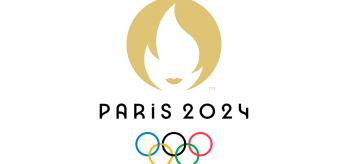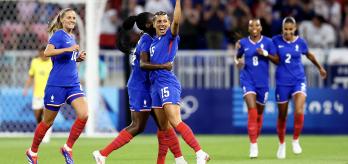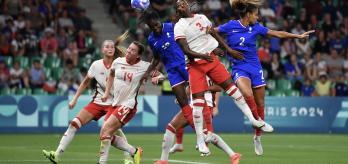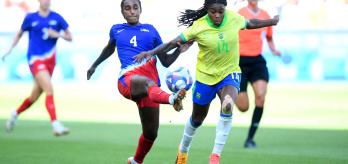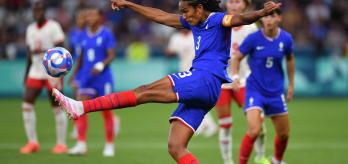Hosts France and reigning champions Canada were the pre-tournament favourites in Group A, and both advanced to the quarter-finals alongside Colombia, who finished as one of the two best third-placed teams in the group stage. The Canadians won all three of their matches, and finished second, while Colombia’s 2-0 victory over New Zealand in their second game was crucial in securing their progression.
France
In possession, France were dynamic in their attacking play, especially when they played at a high tempo. Their relentless movement and constant rotations made life very difficult for opposition defenders, while the technical ability and quality first touches by their players helped them to generate real speed and momentum as they approached the final third. They showed considerable variety in their attacks, and created plenty of overloads in wide areas through their advancing full-backs. Their attacks were ably supported by their forwards and advanced midfielders, who consistently made offers to receive the ball in behind opposition defensive lines. Moreover, striker Marie-Antoinette Katoto (12), who missed the 2023 FIFA Women’s World Cup™ through injury, looked back to her best form, scoring five of the hosts’ six goals.
When they lost the ball, France applied an aggressive counter-press to regain possession as quickly as possible, while they also looked to press their opponents’ build-up play directly and high up the pitch. This pressure frequently forced errors from their opposition or led them to play the ball long.
Canada
The reigning gold medallists utilised several formations in their group games, demonstrating their tactical flexibility when in possession. They appeared in 1-3-4-3, 1-4-2-3-1 and 1-3-5-2 team shapes across their three matches, adapting to the opposition and the situation in front of them. Captain Jessie Fleming (17) was a key player, driving her team on in every game and scoring the equaliser against France. They proved particularly dangerous when orchestrating attacks from wide areas.
When defending, the Canadians were hard to break down, as they reverted to a 1-4-4-2 defensive block and squeezed the spaces in central areas, forcing their opposition to play wide. Canada have looked very strong physically, and have shown great resilience throughout this tournament so far, something that will stand them in good stead as they progress to the knock-out stages. Their defence is a solid and cohesive team unit, bolstered by the immense leadership qualities of centre-back Kadeisha Buchanan (3).
Colombia
Colombia are excellent technically, with some great individual players, and they used those skills to good effect in the group stage. Forward Linda Caicedo (18) was a particularly influential figure; her game intelligence, her ability to carry the ball at speed, and the fact she can beat defenders 1v1 means she has all the tools to ignite her team as they progress their attacks. Colombia built their play carefully, and were generally happy to enjoy possession and circulate the ball through midfield before advancing play into wide areas. Once in the final third, they tended to take a direct approach and try to get the ball into the penalty area quickly, either by delivering early crosses or by dribbling and taking defenders on.
Out of possession, the South American side defended in a 1-4-4-2 and preferred to start from a mid-block, applying direct pressure as their opponents advanced beyond set trigger points for their press. Colombia varied their play in attacking transition depending on where they recovered the ball and the space available, but they often looked to get the ball forward early via their wide players, or to play it in behind for attacking runners.
New Zealand
With a good mix of experience and youth in their team, New Zealand again proved they are a well-organised team who are continuing to develop. One of their key attacking strategies was to get the ball wide, where they had players who were keen to take defenders on 1v1 and get crosses into the penalty areas. Their two centre-forwards gave them different options for playing into the final third, with one looking to receive the ball to feet and the other making runs in behind the opposition defence. The Football Ferns were also particularly strong on set pieces in the final third.
Without the ball, New Zealand were compact and well connected, maintaining their whole-team defensive shape regardless of where on the pitch they were defending. The 100% commitment of every player on the pitch to get back into that defensive shape in transition was impressive, as were the leadership, experience and communication skills of defenders Catherine Bott (4), Katie Bowen (14) and Rebecca Stott (13).




